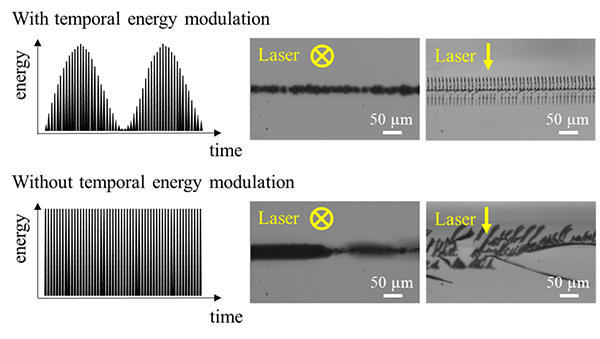High repetition rate ultrashort pulse lasers have been attracting much interest as a tool for local melting, leading to elemental technologies for micro-welding of transparent materials such as a glass substrate.
Local melting is triggered by the non-linear photoexcitation and the successive local heat accumulation. It is well known that such phenomena depend to a larger extent on the laser pulse duration. Particularly, the behavior of photoexcited electron plasma directly effects on a machining accuracy using picosecond laser pulses, because the typical boundary for time scale of motion and thermalization is estimated to be approximately 10 ps.
A crucial issue to be solved for the conventional picosecond laser processing is discontinuous movement of plasma resulting in an irregular stress distribution. Although a picosecond laser pulse system is more attractive for industrial applications due to its compact and low-cost compared to a femtosecond laser system, it should overcome the disadvantage to form homogeneous modification.
The research group of Dr. Shimotsuma from Kyoto University proposed a method to suppress the stress generation during picosecond laser direct writing of molten region in a glass substrate by temporally modulating pulse energy of picosecond laser pulses.
It was published in Chinese Optics Letters, Vol. 18, Issue 12, 2020 (Akinao Nakamura, Tomoki Mizuta, Yasuhiko Shimotsuma, Masaaki Sakakura, Tomohito Otobe, Masahiro Shimizu, Kiyotaka Miura. Picosecond burst pulse machining with temporal energy modulation [Invited][J]. Chinese Optics Letters, 2020, 18(12): 123801.)
Optical micrographs of modified tracks in AlN crystal by picosecond laser pulses with / without temporal energy modulation.
By using the picosecond burst pulse machining with temporal energy modulation, the irregular stress concentration can be suppressed, leading to enhance the energy threshold for crack generation in glass. The stress distribution caused by the plasma movement during picosecond laser machining with and without the temporal modulation was directly observed by using high-speed camera equipped with a pixelated polarizer array which is made from photonic crystal bonded directly to the CMOS sensor.
Furthermore, to discuss the mechanism of the suppression of stress distribution by the temporal energy modulation of picosecond laser pulses, the plasma motion was also simulated, based on the assumption of the generated plasma acting as a complete conductor.
By modulating the pulse energy with adequate frequency according to the thermal diffusion coefficient of material, the induced stress distribution of picosecond laser pulses can be intentionally relaxed to the degree of that for femtosecond laser pulses. The key point of the modification induced by picosecond laser pulses with temporal energy modulation is the stress relaxation caused by the plasma generation and its oscillation along with laser propagation direction. This technique for preventing the stress distribution opens a new possibility for precise micromachining such as laser-welding and laser-slicing using picosecond laser pulses.



